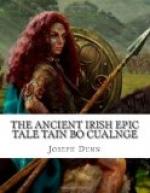* * * * *
In general, I believe it should be the aim of a translator to give a faithful rather than a literal version of his original. But, owing to the fact that so little of Celtic scholarship has filtered down even to the upper strata of the educated public and to the additional fact that the subject matter is so incongruous to English thought, the first object of the translator from the Old Irish must continue to be, for some time to come, rather exactness in rendering than elegance, even at the risk of the translation appearing laboured and puerile. This should not, however, be carried to the extent of distorting his own idiom in order to imitate the idiomatic turns and expressions of the original. In this translation, I have endeavoured to keep as close to the sense and the literary form of the original as possible, but when there is conflict between the two desiderata, I have not hesitated to give the first the preference. I have also made use of a deliberately archaic English as, in my opinion, harmonizing better with the subject. It means much to the reader of the translation of an Old Irish text to have the atmosphere of the original transferred as perfectly as may be, and this end is attained by preserving its archaisms and quaintness of phrase, its repetitions and inherent crudities and even, without suppression or attenuation, the grossness of speech of our less prudish ancestors, which is also a mark of certain primitive habits of life but which an over-fastidious translator through delicacy of feeling might wish to omit. These side-lights on the semi-barbaric setting of the Old Irish sagas are of scarcely less interest and value than the literature itself.
The Tain Bo Cualnge, like most of the Irish saga-tales as they have come down to us in their Middle Irish dress, is chiefly in prose, but interspersed with verse. The verse-structure is very intricate and is mostly in strophic form composed of verses of fixed syllabic length, rhymed and richly furnished with alliteration. There is a third form of speech which is neither prose nor verse, but partakes of the




